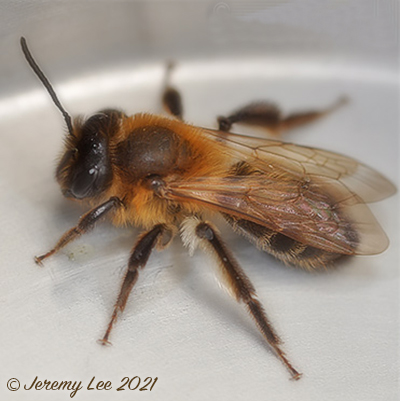
 |
|
Scientific Classifications explained » Amphibians » Ants » Aphids » Bees » Beetles » Birds » Bugs » Butterflies » Caterpillars » Damselflies » Dragonflies » Earwigs » Flies » Frog/Leafhoppers » Fungi » Galls » Grasshoppers » Harvestmen » Hoverflies » Lacewings » Ladybirds » Leaf Mines » Lichens » Mammals » Millipedes » Mosses » Moths » Sawflies » Slugs » Snails » Spiders » Trees & Shrubs » Wasps » Wild Flowers » Woodlice » Postboxes |
UK Nature > Bees > Andrena scotica

Scientific Name: Andrena scotica Common Name: Mining Bee Andrena scotica is a solitary mining bee. These are very hairy bees and at 10 to 14 mm Andrena scotica is one of the larger species, the male being slightly smaller than the female. They especially enjoy firm sandy soils with no overgrowing plants to smother the nest, for this reason they are often found near to pathways. Seen mid March to late June - peaking late April and May. The females share a common entry point during nesting, but underground each female takes care of her own chamber. Using the same entrance without being a real structured community is called communal. Because many chambers share one exit, fresh animals meet each other in this exit while trying to get out for the first time in spring. Males try to mate immediately, so in many cases the females have been fertilised even before seeing daylight. One of the most common Andrena species, with most British records coming from southern, central and north-eastern England. |
|

https://www.uknature.co.uk is a website dedicated to showing the immense diversity of UK nature and wildlife. Our vast range of habitats, from lowland arable to snow covered mountains, from storm-ravaged coastlines to peaceful inland freshwater lakes and rivers, from dry, sandy heaths to deciduous and coniferous forests, all these habitats contribute to the abundance of UK nature. We have wild birds in huge numbers either residing or visiting our shores (597 recorded species as at July 2013) and we must also not forget the humble back garden with its grass lawns, flower beds filled with nectar rich flowers, shrubs and trees, all designed to attract huge numbers of insects such as bees, moths, butterflies and hoverflies; and finally the small ponds which provide safe havens for frogs, toads, newts and even slow worms and grass snakes. www.uknature.co.uk is the showcase for my personal passion, photographing uknature in all its glory. I sincerely hope you all enjoy the fruits of my labours. This site and all images contained therein is © Jeremy Lee 2004 - 2025. All Rights Reserved. Site design by Jeremy Lee. Site development & IT Support by Stuart Lee. |